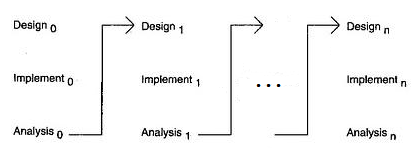Introduction to software development life cycle (SDLC)
Chapters
Iterative model
Generally in all other model we begin the process with a complete requirements specification. But in the Iterative model does not attempt to begin with a complete specification of requirements and the iterative process begins with a very small part of implementation of the requirements and enhances the versions iteratively until the implementation of the system completes and ready to be deployed and each iteration produces a new version of the product at the iteration end of the model.
Iterative model Diagram:

In this model, we create a piece of product in first iteration, then after reviewing it will improve it in upcoming iterations until we get proper get particular product.
Example:

As shown in the above diagram in the first iteration the whole triangle is sketched lightly, in the iteration second lightly colors are filled and in the iteration third finishing is done. Here whole product is developed part by part in iterative model.
When to use iterative model:
- Whenever there is larger project i.e. with number of modules.
- Only some important requirements are defined and some other details can evolve with time.
- When the system has clear and completely defined requirement
Advantages:
- In the early stage of the life cycle, we can develop and make few functionalities works quickly.
- Requirements changes are allowed
- It supports changing requirements
- Application is produced at early stage where customer can evaluate and give the feedback.
- Suitable for complex and larger projects. Example: mission-critical / life critical projects.
- Changes / Modifications in the requirement is not much costlier
- In this model we can measure the progress
- Since this has iteration process, testing and debugging is easier
- We can plan for parallel development
Disadvantages:
- It is not suitable for smaller projects
- Progress of Project is mainly depends upon the risk analysis.
- For risk analysis, experience skilled resources are required.
- Requires more number of resources.
- An iteration of each phase is rigid
In the next chapter we will touch on Big Bang Model
Description
This tutorial covers
- What is SDLC
- Waterfall Model
- Spiral Model
- Prototype Model
- V-Model
- Iterative model
- Big Bang Model
- RAD Model
- Agile Model
- Useful resources to futher your understanding on SDLC
Report any errata directly using our support forms
Audience
Beginners looking to get their hands on understanding of software development life cycle (SDLC)
Learning Objectives
A quick introduction to SDLC
Author: Subject Coach
Added on: 30th Jul 2015
You must be logged in as Student to ask a Question.
None just yet!